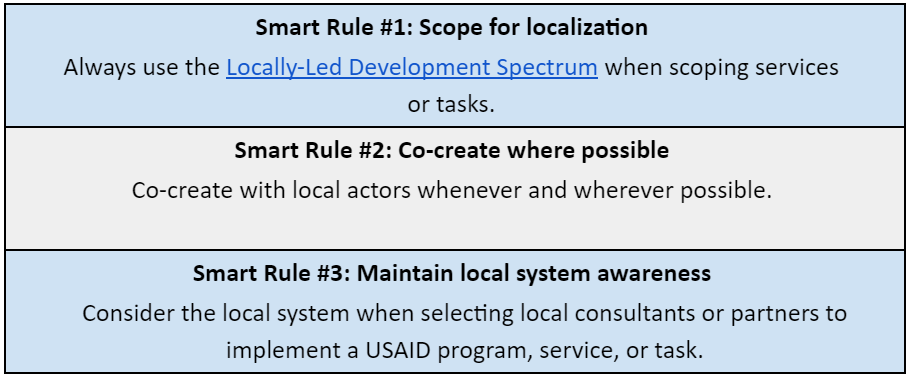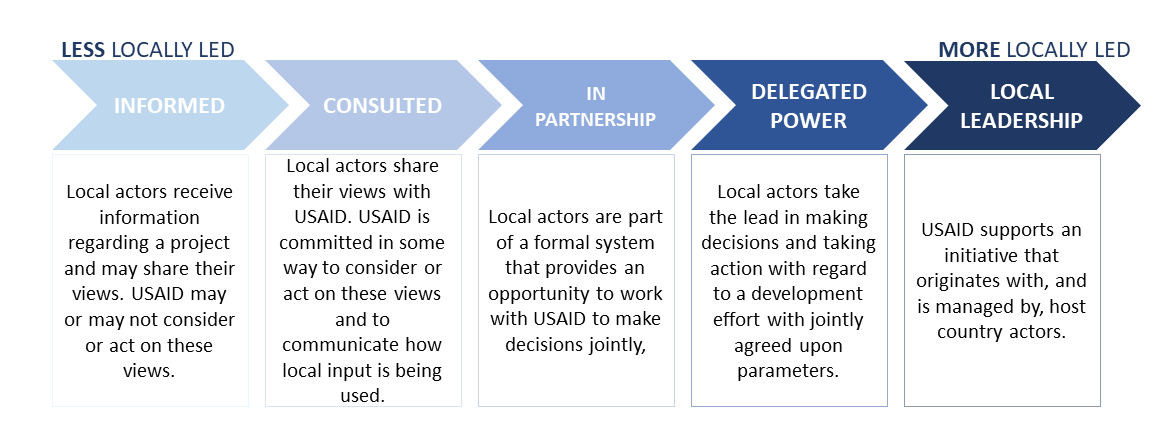Localization in Focus: Can We Get ‘Smarter’ on Localization?
What are our localization Smart Rules?
At Social Impact, we are experimenting with how we can increase and promote localization in our work with all our funders – USAID in particular. We therefore challenged ourselves to come up with a smarter, more systematic, and intentional approach to localization that could guide our staff. What we ended up with were our three “Localization Smart Rules.”

I first heard of the smart rules concept from Duncan Green’s coverage of the way the UK’s Department for International Development (DFID) used them to enable more politically aware and adaptive programming. They are meant to be simple and almost always universal. We believe our Smart Rules for localization can apply to any organization working in development – funders and implementers alike.
Smart Rule #1: Scope for localization.

When scoping services, tasks, or interventions, we can be intentional and plan for localization. We borrow from USAID’s locally-led development spectrum to do so (though we’ve adjusted it to indicate that we believe power shifting to local actors begins at the “in partnership” stage). We ask ourselves and our funders, “where do we want to be along this spectrum for this intervention/task/service?” We’ve begun using this in our Vietnam support contract (USAID Learns) when scoping new assignments with USAID/Vietnam.
Smart Rule #2: Co-create with local actors whenever and wherever possible.
Co-creation means working in partnership and sharing decision-making power. It means the idea is not just mine or yours, but ours. It is the basis of localization because it enhances ownership of the development challenge and its solutions with local actors.
Smart Rule #3: Maintain local system awareness.
This smart rule may be the most complicated to implement. In our position, often as a support mechanism helping USAID or other funders to learn from their programming or design new programming, we have to know the local system to do a good job. Localization without an understanding of the local system could, in fact, backfire. For example, we might (1) misunderstand the significance of research or evaluation findings; (2) recommend ways of working that are not relevant or suitable to the context; or (3) hire or suggest collaborating with local actors who are not credible or appropriate for the situation.
In conversation with USAID’s David Jacobstein about Social Impact’s localization Smart Rules
I had an electronic back and forth about these smart rules with David Jacobstein, long-time colleague and collaborator from USAID’s Bureau for Democracy, Human Rights, and Governance. For years, he has been interested in more accurately shifting power to local actors by clearly defining what work we’re doing and how our legacies may come from how we collaborate.
Monalisa: What’s your reaction to these Smart Rules?
David: I think these Smart Rules are elegant and clear. They fit the bill of being principles-based, taking the right thing to do from the spectrum, and using this to inspire action that each team can define for itself.
Monalisa: What strikes you as most significant?
David: More co-creation, and co-design as part of that, helps us to be clear that local involvement isn’t about new implementers or new ideas; it’s more about transforming our work into investments in locally-led development. As someone who both promotes the Local Systems Framework and the use of a political economy lens, I think the third rule is a good nod in that direction.
Monalisa: Yes, to build on your point, there is such a huge focus on who gets funded, which is no doubt critical, but the reality is that even if USAID accomplishes its goal of 25% of funding going directly to local partners, presumably 75% still isn’t. That means localization also has to be about transforming the rest of the work as well into locally-led development.
Monalisa: Where would you push us to reconsider or adjust?
David: I think the third rule could be more ambitious – knowing who might win or lose from change, for example, isn’t just a matter of partnering carefully, but of shaping policy agendas and project designs to blend feasibility as well as desirability of change. Going far by going together is as much a change strategy as a partnering approach. I might suggest splitting it into a third rule of “anticipate system shifts” and a fourth rule of “maintain systemic awareness.”
Monalisa: I like that. We have maybe limited ourselves in the application of the third rule. It could also be a result of where we sit in the system, typically in a support function to USAID rather than a direct implementer. For now, we’ll keep it as is because we went through an internal process to develop these rules, but will definitely keep this feedback in mind for the future.
David: Overall, I applaud the clear and simple steps toward shifting ourselves and imagining better ways of working, and work to be done.
Call to action
Advancing locally-led development is a complex process with no silver bullet. Our smart rules are an effort to become more intentional about local leadership in our programming, and we continue to learn about works best. Nevertheless, if we start institutionalizing these rules and changing our behaviors in international organizations and donor agencies, it could have a positive butterfly effect. Each new scope that outlines the degree of expected localization (Smart Rule #1) forces us to plan accordingly. Ideally, our intention in each case will be to work at least “in partnership,” leading to co-creation in design and implementation (Smart Rule #2). And throughout our work, if we can maintain that system awareness (Smart Rule #3), we will “go far by going together,” as David notes.
I would love to see other organizations apply these Smart Rules to their contexts. Please feel free to borrow ours here! If they don’t work for you, develop others that are simple, universal, and actionable and don’t forget to share them! Each drop in the bucket gets us closer to the sea change I think many of us are hoping for on localization.



